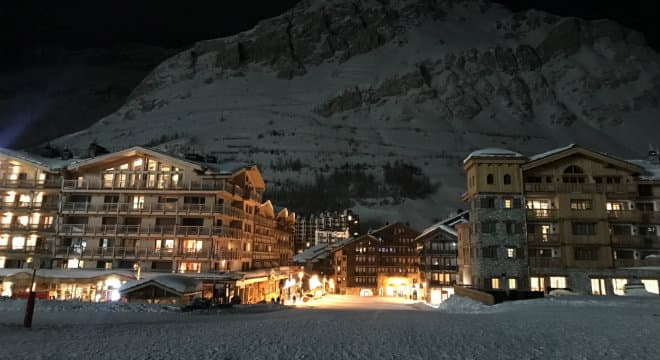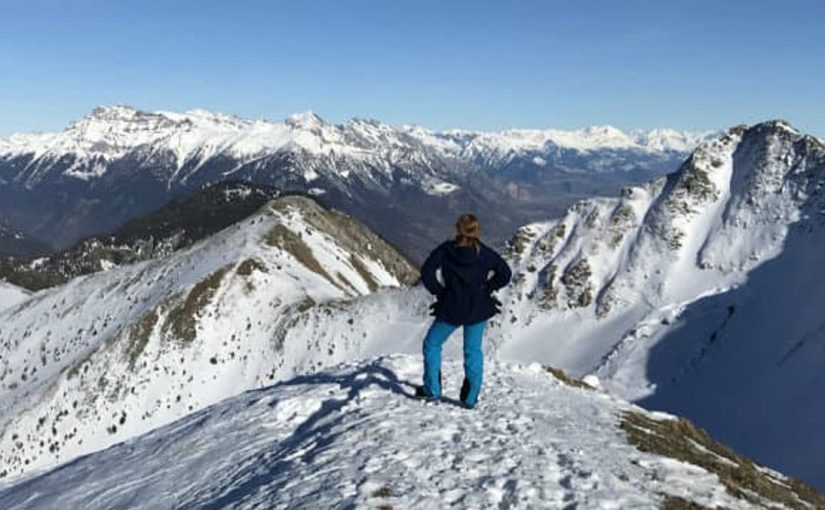In Dec ’19 we were contacted by Juliana Gansl from ultimate-ski.com. She was coming to Europe to ski Val d’Isere, Val Thorens and Chamonix.
TDCski was delighted to have her sign up for a few off-piste backcountry guiding sessions so that we could get the chance to show her around what we already know to be the brilliant skiing on offer in Val d’Isere and Tignes.
Here is Juliana’s thoughts on Val d’Isere –
You can read the full article here.
Val d’Isere

©Juliana Gansl
After landing in Lyon, I got my rental car and started the 2.5-hour drive to Val d’Isere at the eastern end of the Vanoise National Park. Several Brits I met described Val d’Isere as a “chocolate box town,” meaning it’s wonderfully picturesque. They were right.
The main street is lined with ski stores, bakeries, restaurants and bars. Some of the side streets are located next to the base area, making everything centrally located and easily accessible. Val d’Isere, combined with its neighbouring resort, Tignes, make up one of the largest ski regions in France – the Espace Killy I purchased a 6-day pass with access to both resorts for USD $290 (including insurance for $2 per day, which would come in handy in case of an emergency). I also pre-booked two off-piste group guided days with The Development Centre (TDC), so that I could explore more challenging terrain and get the most out of the Espace Killy.
Pro-Tip: for skiers used to North American resorts – where mostly all trails, trees and bowls are considered in-bounds and therefore avalanche controlled, patrolled and marked – in Europe, plenty of lift-accessible terrain isn’t avalanche controlled, patrolled or marked. Make sure to familiarize yourself with Europe’s piste and off-piste definitions to avoid ending up in potentially life-threatening situations. Local piste maps are clear, but if in any doubt check your understanding on arrival.
My guides, Steve Angus and Rich Jones, were both professional, easy to communicate with, and extremely knowledgeable about the area. I happened to ski with them on two of the cloudier days, and they did an excellent job of finding untouched powder runs unaffected by the wind. Most importantly, I felt incredibly safe in their care, and would highly recommend them both.
Pro Tip: ensure you have a good low-light lens when skiing in Europe as most resorts are above the tree line, which means that visibility will always be poor when it’s cloudy.
As a solo traveler, I made a sincere effort to talk to strangers and say yes to as much as possible. My first afternoon after skiing I stopped into Chez Jules and the owner and I ended up taking shots of Génépy – an aperitif native to the region – in honor of sharing the same first name. On my second day, I started chatting with a group of young French skiers on the gondola and ended up skiing the entire day with them – including stopping for a delicious lunch at La Fruitiere and then for champagne and dessert at the infamous La Folie Douce next door. While walking around town another night, I befriended a group of lads from Manchester, UK, and met them the next several afternoons at CocoRico to dance on tables and drink caramel flavored Polish vodka.
In Val d’Isere my AirBnB apartment was in a small building located on Rue du Cachay in Rond Point des Pistes, next to the central bus round-about. It was a one-minute walk to the Solaise and Olympique lifts, 30 seconds to the CocoRico, and 5 minutes to the main street (just walk across the ski trail). The apartment luckily included a free, covered parking spot. I highly recommend staying in this area if options are available.
When my seventh day came, I was truly sad to have to leave Val d’Isere – I would have been perfectly happy spending my entire trip in The Espace Killy – but the Three Valleys was up next.
Ultimate-Ski guide to Val d’Isere >
Read Juliana’s full article here.
